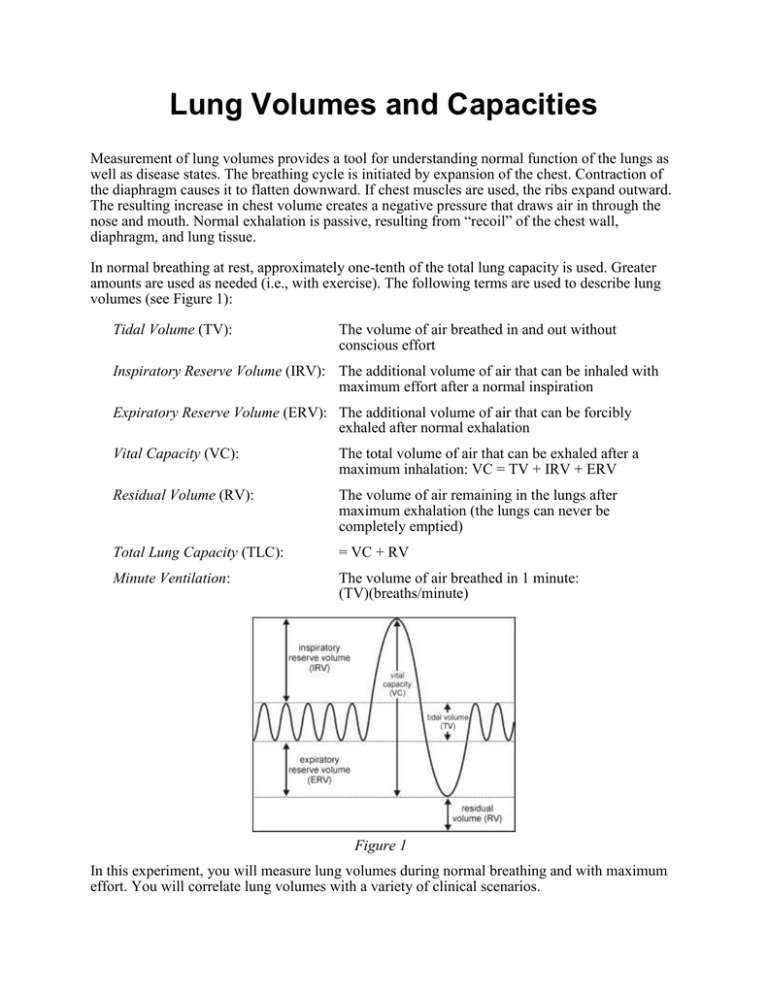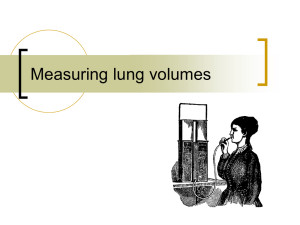Lung Volumes and Capacities
advertisement

Lung Volumes and Capacities Measurement of lung volumes provides a tool for understanding normal function of the lungs as well as disease states. The breathing cycle is initiated by expansion of the chest. Contraction of the diaphragm causes it to flatten downward. If chest muscles are used, the ribs expand outward. The resulting increase in chest volume creates a negative pressure that draws air in through the nose and mouth. Normal exhalation is passive, resulting from “recoil” of the chest wall, diaphragm, and lung tissue. In normal breathing at rest, approximately one-tenth of the total lung capacity is used. Greater amounts are used as needed (i.e., with exercise). The following terms are used to describe lung volumes (see Figure 1): Tidal Volume (TV): The volume of air breathed in and out without conscious effort Inspiratory Reserve Volume (IRV): The additional volume of air that can be inhaled with maximum effort after a normal inspiration Expiratory Reserve Volume (ERV): The additional volume of air that can be forcibly exhaled after normal exhalation Vital Capacity (VC): The total volume of air that can be exhaled after a maximum inhalation: VC = TV + IRV + ERV Residual Volume (RV): The volume of air remaining in the lungs after maximum exhalation (the lungs can never be completely emptied) Total Lung Capacity (TLC): = VC + RV Minute Ventilation: The volume of air breathed in 1 minute: (TV)(breaths/minute) Figure 1 In this experiment, you will measure lung volumes during normal breathing and with maximum effort. You will correlate lung volumes with a variety of clinical scenarios. OBJECTIVES In this experiment, you will Obtain graphical representation of lung capacities and volumes. Compare lung volumes between males and females. Correlate lung volumes with clinical conditions. MATERIALS computer Vernier computer interface Logger Pro Vernier Spirometer disposable mouthpiece disposable bacterial filter nose clip PROCEDURE Important: Do not attempt this experiment if you are currently suffering from a respiratory ailment such as the cold or flu. 1. Connect the Spirometer to the Vernier computer interface. Open the file “19 Lung Volumes” from the Human Physiology with Vernier folder. 2. Attach the larger diameter side of a bacterial filter to the “Inlet” side of the Spirometer. Attach a gray disposable mouthpiece to the other end of the bacterial filter (see Figure 2). Figure 2 3. Hold the Spirometer in one or both hands. Brace your arm(s) against a solid surface, such as a table, and click to zero the sensor. Note: The Spirometer must be held straight up and down, as in Figure 2, and not moved during data collection. 4. Collect inhalation and exhalation data. a. Put on the nose plug. b. Click to begin data collection. c. Taking normal breaths, begin data collection with an inhalation and continue to breathe in and out. After 4 cycles of normal inspirations and expirations fill your lungs as deeply as possible (maximum inspiration) and exhale as fully as possible (maximum expiration). It is essential that maximum effort be expended when performing tests of lung volumes. d. Follow this with at least one additional recovery breath. 5. Click to end data collection. 6. Click the Next Page button, , to see the lung volume data. If the baseline on your graph has drifted, use the Baseline Adjustment feature to bring the baseline volumes closer to zero, as in Figure 3. 7. Select a representative peak and valley in the Tidal Volume portion of your graph. Place the cursor on the peak and click and drag down to the valley that follows it. Enter the y value displayed in the lower left corner of the graph to the nearest 0.1 L as Tidal Volume in Table 1. Figure 3 8. Move the cursor to the peak that represents your maximum inspiration. Click and drag down the side of the peak until you reach the level of the peaks graphed during normal breathing. Enter the y value displayed in the lower left corner of the graph to the nearest 0.1 L as Inspiratory Reserve Volume in Table 1. 9. Move the cursor to the valley that represents your maximum expiration. Click and drag up the side of the peak until you reach the level of the valleys graphed during normal breathing. Enter the y value displayed in the lower left corner of the graph to the nearest 0.1 L as Expiratory Reserve Volume in Table 1. 10. Calculate the Vital Capacity and enter the total to the nearest 0.1 L in Table 1. VC = TV + IRV + ERV 11. Calculate the Total Lung Capacity and enter the total to the nearest 0.1 L in Table 1. (Use the value of 1.5 L for the RV.) TLC = VC + RV 12. Share your data with your classmates and complete the Class Average columns in Table 1. DATA Table 1 Individual (L) Class average (Male) (L) Class average (Female) (L) Tidal Volume (TV) 0.2 2.0 2.1 Inspiratory Reserve (IRV) 1.2 5.0 2.1 Expiratory Reserve (ERV) 2.6 4.0 3.2 Vital Capacity (VC) 4.0 11.0 7.4 Residual Volume (RV) ≈1.5 ≈1.5 ≈1.5 Volume measurement (L) Total Lung Capacity (TLC) 5.5 12.5 8.9 DATA ANALYSIS 1. What was your Tidal Volume (TV)? What would you expect your TV to be if you inhaled a foreign object which completely obstructed your right mainstem bronchus? Our Tidal Volume was 0.2. If we inhaled a foreign object the obstructed our right mainstem bronchus, we would expect to have a less TV because it decreased by a half. 2. Describe the difference between lung volumes for males and females. What might account for this? The difference between male lung volumes and female lung volumes is the size differences between the two. For example, a taller person will have a higher volume than a shorter person. 3. Calculate your Minute Volume at rest. (TV breaths/minute) = Minute Volume at rest If you are taking shallow breaths (TV = 0.20 L) to avoid severe pain from rib fractures, what respiratory rate will be required to achieve the same minute volume? Since our data had the same breaths given (TV=0.2), it would turn out to be the same. If our data was different, we would expect to have more breaths to obtain 4. Exposure to occupational hazards such as coal dust, silica dust, and asbestos may lead to fibrosis, or scarring of lung tissue. With this condition, the lungs become stiff and have more “recoil.” What would happen to TLC and VC under these conditions? The total lung capacity and the vital capacity of the lungs is greatly affected when fibrosis takes place. The ability to breathe is greatly affected and made much more difficult considering the scarring of the lung tissue. 5. In severe emphysema there is destruction of lung tissue and reduced recoil. What would you expect to happen to TLC and VC? The total lung capacity and vital capacity are both greatly affected when emphysema is present, due to the destruction of the lung tissue and reduced recoil. 6. What would you expect to happen to your Expiratory Reserve Volume when you are treading water in a lake? The Expiratory Reserve Volume would double its normal output because of the work that is being exerted.







